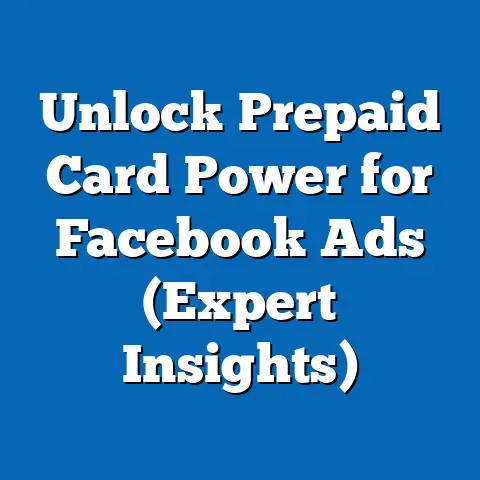Maximize ROI with Facebook Ad Coupons (Crypto Strategy)
Imagine a young entrepreneur, Alex, sitting in a trendy co-working space in a bustling city, surrounded by the hum of productivity and the glow of multiple screens. It’s 2023, and Alex, a 28-year-old digital native, is part of the Millennial generation, balancing a laptop, a smartphone, and a cold brew coffee while strategizing the next big move in the cryptocurrency market. This is not just a job; it’s a lifestyle defined by adaptability, tech-savviness, and a relentless pursuit of financial independence in a world shaped by economic uncertainty and digital innovation.
Alex’s daily grind involves navigating the volatile crypto market, where fortunes can be made or lost in hours, and leveraging social media platforms like Facebook to reach potential investors or customers for a crypto-related startup. The defining characteristic of this lifestyle is the fusion of technology and finance, where tools like Facebook ad coupons become a gateway to cost-effective marketing in a hyper-competitive digital landscape. This scene encapsulates a broader societal shift: the rise of the “digital hustler,” a persona shaped by economic challenges, technological advancements, and the democratization of investment opportunities like cryptocurrency.
Historically, the early 21st century has seen rapid changes in how individuals approach wealth creation, driven by the 2008 financial crisis, the advent of blockchain technology, and the explosive growth of social media advertising. These events have not only shaped Millennials like Alex but also Gen Z, who are entering the workforce with an innate understanding of digital tools and a skepticism of traditional financial systems. The societal implications are profound, as these generations redefine work, investment, and marketing through decentralized systems and online platforms, challenging established norms and creating new economic paradigms.
Section 1: Generational Dynamics and the Digital Hustler
The rise of the digital hustler is closely tied to the characteristics and experiences of Millennials (born 1981–1996) and Gen Z (born 1997–2012), who have come of age in an era defined by technological disruption and economic instability. Millennials, often shaped by the 2008 financial crisis, witnessed the fragility of traditional financial systems and sought alternative paths to financial security, including entrepreneurship and investment in emerging technologies like cryptocurrency. Gen Z, growing up with smartphones and social media as constants, approaches the digital world with an intuitive ease, often blending personal branding with business ventures from a young age.
Both generations share a skepticism of centralized authority—whether in finance or governance—partly due to historical events like the Great Recession, the Snowden leaks revealing mass surveillance, and ongoing global economic inequality. This skepticism has fueled interest in decentralized systems like blockchain and cryptocurrencies such as Bitcoin and Ethereum, which promise transparency and autonomy. According to a 2021 survey by Morning Consult, 48% of Millennials and 42% of Gen Z in the U.S. have invested in or are interested in cryptocurrency, compared to just 25% of Gen X and 11% of Baby Boomers.
However, these generations are not monolithic. Within Millennials, there are stark differences between early and late members of the cohort, with older Millennials often burdened by student debt and housing costs, while younger ones may have adapted earlier to gig economy opportunities. Similarly, Gen Z’s diversity spans cultural backgrounds and access to technology, influencing how they engage with crypto and digital marketing. Despite these nuances, a common thread is their reliance on social media as a tool for networking, learning, and marketing—making platforms like Facebook a critical arena for reaching their peers.
The societal impact of this generational shift is significant. As digital hustlers prioritize flexibility and innovation over traditional career paths, they are reshaping labor markets and consumer behavior. Their embrace of crypto and digital tools also challenges regulatory frameworks, raising questions about taxation, security, and financial inclusion. Understanding these dynamics is crucial for any strategy involving crypto marketing, as it highlights the audience’s values, behaviors, and technological fluency.
Section 2: Historical Context of Crypto and Social Media Marketing
The intersection of cryptocurrency and social media marketing cannot be understood without examining the historical developments that paved the way for both. Cryptocurrency emerged with the release of Bitcoin in 2009 by the pseudonymous Satoshi Nakamoto, in the wake of the 2008 financial crisis, as a response to distrust in centralized banking systems. Bitcoin introduced the concept of a decentralized, peer-to-peer digital currency secured by blockchain technology, which promised to eliminate intermediaries and reduce transaction costs.
Parallel to this, social media platforms like Facebook transformed from social networking tools into powerful marketing engines. Launched in 2004, Facebook introduced targeted advertising in 2007, allowing businesses to reach specific demographics based on user data. By the 2010s, Facebook ads had become a cornerstone of digital marketing, with small businesses and entrepreneurs leveraging the platform’s vast user base—over 2.9 billion monthly active users as of 2023, per Statista—to promote products and services cost-effectively.
The convergence of crypto and social media marketing was inevitable. Crypto projects, often lacking traditional funding or institutional backing, turned to platforms like Facebook to build communities, attract investors, and promote token sales. However, regulatory crackdowns, such as Facebook’s 2018 ban on crypto-related ads (later partially lifted), underscored the tension between innovation and oversight. Today, with relaxed policies and the availability of ad coupons—discounts or credits offered by Facebook or third parties—crypto marketers have a unique opportunity to maximize ROI while navigating a complex landscape.
Section 3: Understanding Facebook Ad Coupons in Crypto Marketing
Facebook ad coupons are promotional credits or discounts provided to advertisers, often as incentives for new users, during special campaigns, or through partnerships with third-party platforms. These coupons can range from $10 to $500 or more, depending on the promotion, and are designed to lower the initial cost of advertising, allowing businesses to test campaigns with minimal financial risk. For crypto marketers, who often operate on tight budgets or face high customer acquisition costs due to market skepticism, these coupons represent a strategic tool to amplify reach and engagement.
The mechanics of using Facebook ad coupons are straightforward but require careful planning. Advertisers must create a Facebook Business Manager account, set up a payment method, and apply the coupon code during campaign setup. The coupon typically covers a portion of ad spend over a specified period, though terms vary—some require a minimum spend to activate, while others are time-sensitive. Crypto campaigns often focus on objectives like brand awareness, lead generation, or driving traffic to whitepapers and token sale pages, making precise targeting essential.
However, the crypto niche faces unique challenges on Facebook. Despite policy relaxations, ads must comply with strict guidelines, such as avoiding misleading claims about returns and obtaining prior approval for crypto-related content. According to a 2022 report by Hootsuite, crypto ads have a higher rejection rate (around 15%) compared to other industries (under 5%) due to compliance issues. This underscores the importance of crafting transparent, value-focused messaging that aligns with platform rules while leveraging the cost savings of coupons.
Data highlights the potential ROI of such strategies. A 2021 study by WordStream found that the average cost-per-click (CPC) for Facebook ads in the finance and insurance sector (including crypto) is around $3.77, higher than many other industries. By using ad coupons, marketers can offset initial costs, test different audiences, and optimize campaigns before committing larger budgets. For instance, a $100 coupon could fund a pilot campaign reaching 5,000 users, providing valuable insights into click-through rates (CTR) and conversion metrics.
Section 4: Crafting a Crypto Strategy with Facebook Ads
Maximizing ROI with Facebook ad coupons in the crypto space requires a multi-faceted strategy that balances cost efficiency with audience engagement. The first step is defining clear objectives—whether it’s building a community around a new token, driving traffic to a decentralized finance (DeFi) platform, or educating users about blockchain technology. Each goal demands tailored ad formats, from video ads showcasing project vision to carousel ads highlighting key features.
Targeting is paramount, given the diverse crypto audience. Millennials and Gen Z, as noted earlier, are prime demographics, often segmented by interests (e.g., technology, investing), behaviors (e.g., past engagement with crypto content), and geographic regions with high crypto adoption (e.g., North America, parts of Asia). Facebook’s detailed targeting options allow advertisers to reach niche groups, such as early adopters or tech enthusiasts, while lookalike audiences can expand reach based on existing customer data. A 2023 report by eMarketer suggests that hyper-targeted Facebook campaigns can achieve up to 30% higher conversion rates compared to broad targeting.
Creative content is equally critical. Crypto ads must address user pain points—such as distrust in traditional finance or fear of missing out (FOMO) on emerging trends—while maintaining transparency to build trust. High-quality visuals, concise copy, and clear calls-to-action (CTAs) like “Join Our Community” or “Learn More About DeFi” can boost engagement. Testing multiple ad variations through A/B testing, often facilitated by initial coupon budgets, helps identify what resonates most with audiences.
Finally, tracking and optimization are non-negotiable. Using tools like Facebook Pixel, marketers can monitor conversions, retarget users who showed interest, and refine campaigns in real-time. Metrics such as CTR, cost-per-lead (CPL), and return on ad spend (ROAS) provide actionable insights. For example, a crypto startup using a $50 coupon might achieve a ROAS of 3x by reinvesting learnings into scaled campaigns, as reported in case studies by Social Media Examiner.
Section 5: Economic and Social Implications of Crypto Marketing Strategies
Socially, however, this trend raises concerns about misinformation and risk. Crypto scams, often promoted through social media, have cost consumers billions, with the U.S. Federal Trade Commission reporting $1.4 billion in losses from crypto fraud in 2021 alone. While ad coupons enable legitimate projects to gain traction, they can also be exploited by bad actors, amplifying the need for consumer education and stricter platform oversight. Generational differences play a role here—while Millennials and Gen Z are tech-savvy, they may overestimate their ability to spot scams, as suggested by a 2023 Pew Research study on digital literacy.
In the workplace, crypto marketing strategies are reshaping skill demands. Digital hustlers and traditional marketers alike must now master blockchain concepts, compliance rules, and social media algorithms, creating a hybrid skill set that blends finance and tech. This evolution could widen the digital divide, as older generations or those without access to training struggle to keep pace, highlighting the need for inclusive education initiatives.
Culturally, the normalization of crypto through platforms like Facebook shifts societal attitudes toward money and investment. As decentralized finance gains visibility, concepts like “being your own bank” challenge traditional norms, particularly among younger generations who value autonomy. Yet, this cultural shift also risks exacerbating wealth inequality if gains remain concentrated among early adopters or tech elites, a concern echoed by economists like Thomas Piketty in discussions of digital economies.
Section 6: Challenges and Ethical Considerations
While Facebook ad coupons offer a pathway to high ROI, they come with challenges and ethical dilemmas specific to the crypto space. Regulatory uncertainty is a major hurdle—different countries have varying stances on crypto advertising, and platforms like Facebook may reinstate restrictions if fraud spikes. Marketers must stay updated on policies and prioritize compliance, even if it means slower campaign rollouts.
Budget management is another challenge. Coupons provide a temporary boost, but over-reliance can distort long-term cost expectations, leading to unsustainable strategies. Experts like digital marketing strategist Neil Patel caution against viewing coupons as a crutch, advocating for organic growth alongside paid efforts. Additionally, audience fatigue is a risk in the oversaturated crypto ad space, where users may ignore repetitive or overly promotional content, as noted in a 2023 HubSpot report on ad trends.
Ethically, crypto marketers must grapple with the responsibility of promoting high-risk investments. Transparency about risks, avoiding exaggerated claims, and targeting only informed audiences are critical to maintaining trust. The generational lens adds complexity—Gen Z, for instance, may be more susceptible to FOMO-driven ads due to social media exposure, raising questions about exploitation versus empowerment. Balancing profit motives with social good remains an ongoing debate in this field.
Section 7: Future Outlook and Uncertainties
Looking ahead, the synergy of Facebook ad coupons and crypto marketing holds immense potential but is fraught with uncertainties. Advances in AI and machine learning could enhance ad targeting precision, allowing crypto projects to reach hyper-specific audiences at lower costs, potentially increasing ROI further. Blockchain innovations like Web3—envisioning a decentralized internet—may also integrate with social platforms, creating new advertising models that reward users directly, as speculated by tech futurists like Tim O’Reilly.
However, regulatory developments loom large. Governments worldwide are tightening crypto oversight, with the EU’s Markets in Crypto-Assets (MiCA) regulation and U.S. SEC actions signaling stricter rules by 2025. Such changes could impact ad policies on platforms like Facebook, limiting coupon use for crypto campaigns. Moreover, economic factors—such as inflation or crypto market crashes—could dampen consumer interest, reducing ad effectiveness.
Generational shifts will also shape the landscape. As Gen Alpha (born 2013 onwards) enters the digital sphere, their expectations for authenticity and interactivity may demand new ad formats, challenging current strategies. Meanwhile, aging Millennials may shift focus from speculative investments to stability, altering crypto’s core audience. Predicting these trends requires ongoing research and adaptability, as the digital hustler lifestyle evolves with each technological and societal wave.
Conclusion: Navigating the Digital Frontier
Maximizing ROI with Facebook ad coupons in the crypto space is a powerful strategy for digital hustlers like Alex, embodying the ingenuity and risk-taking of Millennials and Gen Z in a tech-driven world. By leveraging historical insights, understanding generational dynamics, and crafting targeted campaigns, marketers can harness these tools to build communities and drive innovation. Yet, the path is not without obstacles—regulatory, ethical, and economic challenges demand vigilance and responsibility.
The societal implications of this trend are vast, from reshaping financial systems to redefining cultural attitudes toward wealth and technology. As we look to the future, the interplay of crypto and social media marketing will likely continue to disrupt norms, offering opportunities for inclusion and growth while posing risks of inequality and misinformation. Embracing this complexity with a commitment to transparency and adaptability will be key to sustaining success in this dynamic digital frontier.






